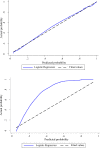Clinical diagnostic model for sciatica developed in primary care patients with low back-related leg pain
- PMID: 29621243
- PMCID: PMC5886387
- DOI: 10.1371/journal.pone.0191852
Clinical diagnostic model for sciatica developed in primary care patients with low back-related leg pain
Abstract
Background: Identification of sciatica may assist timely management but can be challenging in clinical practice. Diagnostic models to identify sciatica have mainly been developed in secondary care settings with conflicting reference standard selection. This study explores the challenges of reference standard selection and aims to ascertain which combination of clinical assessment items best identify sciatica in people seeking primary healthcare.
Methods: Data on 394 low back-related leg pain consulters were analysed. Potential sciatica indicators were seven clinical assessment items. Two reference standards were used: (i) high confidence sciatica clinical diagnosis; (ii) high confidence sciatica clinical diagnosis with confirmatory magnetic resonance imaging findings. Multivariable logistic regression models were produced for both reference standards. A tool predicting sciatica diagnosis in low back-related leg pain was derived. Latent class modelling explored the validity of the reference standard.
Results: Model (i) retained five items; model (ii) retained six items. Four items remained in both models: below knee pain, leg pain worse than back pain, positive neural tension tests and neurological deficit. Model (i) was well calibrated (p = 0.18), discrimination was area under the receiver operating characteristic curve (AUC) 0.95 (95% CI 0.93, 0.98). Model (ii) showed good discrimination (AUC 0.82; 0.78, 0.86) but poor calibration (p = 0.004). Bootstrapping revealed minimal overfitting in both models. Agreement between the two latent classes and clinical diagnosis groups defined by model (i) was substantial, and fair for model (ii).
Conclusion: Four clinical assessment items were common in both reference standard definitions of sciatica. A simple scoring tool for identifying sciatica was developed. These criteria could be used clinically and in research to improve accuracy of identification of this subgroup of back pain patients.
Conflict of interest statement
Figures

References
-
- Kongsted A, Kent P, Jensen TS, Albert H, Manniche C (2013) Prognostic implications of the Quebec Task Force classification of back-related leg pain: an analysis of longitudinal routine clinical data. BMC Musculoskeletal Disord 14: 171 doi: 10.1186/1471-2474-14-171 - DOI - PMC - PubMed
-
- Hill JC, Konstantinou K, Egbewale BE, Dunn KM, Lewis M, et al. (2011) Clinical outcomes among low back pain consulters with referred leg pain in primary care. Spine 36: 2168–2175. doi: 10.1097/BRS.0b013e31820712bb - DOI - PubMed
-
- Bogduk N (2009) On the definitions and physiology of back pain, referred pain, and radicular pain. Pain 147: 17–19. doi: 10.1016/j.pain.2009.08.020 - DOI - PubMed
-
- Stynes S, Konstantinou K, Dunn KM, Lewis M, Hay EM (2016) Reliability among clinicians diagnosing low back-related leg pain. Eur Spine J. 25: 2734–2740. doi: 10.1007/s00586-015-4359-2 - DOI - PubMed
-
- Lin CW, Verwoerd AJ, Maher CG, Verhagen AP, Pinto RZ, Luijsterburg P, et al. (2014) How is radiating leg pain defined in randomized controlled trials of conservative treatments in primary care? A systematic review. Eur J Pain 18: 455–464. doi: 10.1002/j.1532-2149.2013.00384.x - DOI - PubMed
Publication types
MeSH terms
Grants and funding
LinkOut - more resources
Full Text Sources
Other Literature Sources
Medical

